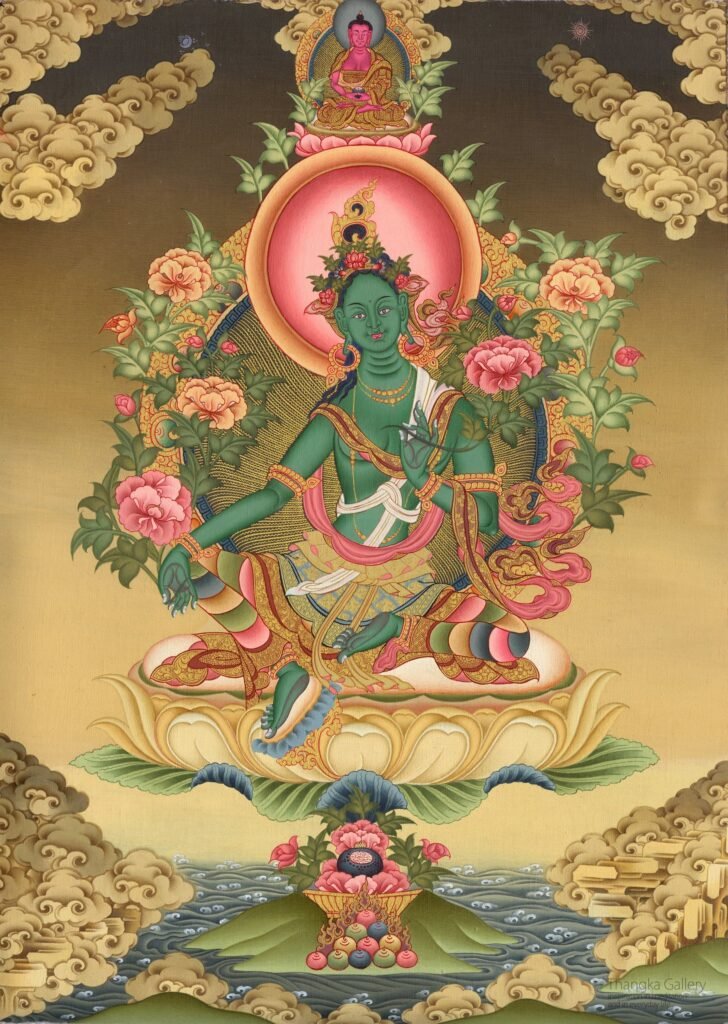Green Tara: The Protector and Savior
In the rich tapestry of Tibetan Buddhism, Tara holds a special place as a compassionate savior and spiritual mother. Known as “度母” in Chinese, Tara is celebrated in various forms, notably Green Tara, White Tara, and Red Tara. These forms represent different aspects of compassion and protection, making Tara an accessible and revered figure in Buddhist practice.
Green Tara, often considered the original Tara, is a symbol of active compassion. She is believed to help followers overcome physical, emotional, and spiritual hardships. Her depiction in Buddhist art and statues, commonly found in temples across India and Tibet, reflects her importance in Buddhist teachings and culture.
The “Tantra of Tara,” a pivotal text in Tibetan Buddhism, details the practices and teachings associated with Tara. Translated into multiple languages, including Chinese and Korean, this text underscores the global relevance of Tara’s teachings. Practitioners worldwide find solace and guidance in these teachings, using them to navigate life’s challenges.
Tara’s backstory is both inspiring and revolutionary. Initially a princess, she encountered Buddhism and dedicated herself to a life of enlightenment. Her commitment to achieving enlightenment in a female form challenged prevailing norms and highlighted the inclusive nature of Buddhist philosophy.

The Practice and Benefits of Green Tara
Devotees believe that practicing the sacred rituals of Green Tara can break the cycle of life and death, remove obstacles, alleviate illness, and bring about prosperity, longevity, and wisdom. Particularly, it is claimed that those who desire children, wealth, or any specific wish will have their wishes fulfilled through her blessings. They chant her mantra, “Om Tare Tuttare Ture Soha,” with the belief that it can grant wishes and fulfill desires.
Iconography of Green Tara in Thangkas
In Thangka paintings, Green Tara is depicted as a young woman of serene beauty, clothed in radiant green, symbolizing life and hope. She has a compassionate visage, similar to a Bodhisattva, with a jeweled crown adorned with rubies, representing her spiritual father, Amitabha Buddha. She wears various jewel ornaments and heavenly garments, signifying her divine status.
According to the teachings, Lord Vairocana Buddha spoke of the merits of Green Tara in this way: those who respectfully recite the mantra “Om Tare Tuttare Ture Soha” and the “Twenty-One Praises to Tara” with deep faith and devotion can overcome all fears and dangers from both human and non-human entities. Believers hold that the practice purifies negative karma resulting from actions of the body, speech, and mind. It is also believed to prevent rebirth in suffering realms like hell, hungry ghosts, and animal realms.

Furthermore, those who practice Tara’s teachings believe that all Buddhas in the ten directions quickly confer empowerment upon them. They trust that they receive immense benefits and swiftly attain Buddhahood for the benefit of all sentient beings. Additionally, they assert that prayers to Green Tara eliminate all forms of poisoning, demonic influences, and unseen dangers.

Symbols and Postures of Green Tara
- Right-hand Gesture: Her right hand in the gesture of granting wishes and realizations symbolizes that her practice can satisfy beings’ desires for happiness, health, wealth, and mundane achievements.
- Left-hand Gesture: Her left hand in the gesture of refuge indicates that she embodies the roles of spiritual teacher, deity, and protector. Holding a blue lotus, she represents purity and beauty attainable in everyday life.
- Leg Postures: Her right leg extended downward signifies active engagement in worldly affairs, while her left leg in meditation posture on a lotus moon disc shows that despite her worldly activities, her mind remains in a state of meditative balance.
Green Tara’s Role in Tibetan Devotion
Green Tara stands as a powerful figure in Tibetan Buddhism, symbolizing active compassion, protection, and fulfillment of worldly and spiritual desires. Her presence in Thangka art and practice in daily rituals highlight her role as a compassionate savior, providing hope and relief to all beings. For practitioners and followers, Green Tara is not just a deity but a guiding force, encouraging active compassion and spiritual balance.
Spiritual Benefits and Enlightenment
Devotion to Green Tara reportedly attracts the blessings of all Buddhas. Those who faithfully follow her teachings are believed to receive spiritual empowerment and immense benefits, thus accelerating their journey towards enlightenment.

Healing and Protection from Green Tara
Green Tara’s prayers are especially powerful in healing and protection. They are believed to shield practitioners from poisons, diseases, and unseen dangers. This protective aspect extends beyond personal safety, offering healing and safeguarding others from various ailments and misfortunes.
Fertility and Financial Success
People also seek Green Tara for personal issues such as childlessness or financial struggles. They claim that dedicated practices, like short retreats that incorporate her mantra and praises, bring about desired outcomes, including the birth of children and the resolution of financial difficulties.
Conclusion: The Universal Appeal of Green Tara
In summary, Green Tara embodies a powerful, compassionate force in Tibetan Buddhism. Her practices are not only spiritually uplifting but also provide practical solutions to everyday problems. Whether it’s seeking healing, protection, success, or enlightenment, Green Tara’s teachings offer a path to a more fulfilled and balanced life. Her universal appeal lies in her ability to address a wide range of human concerns, making her an enduring figure in the Buddhist tradition.

